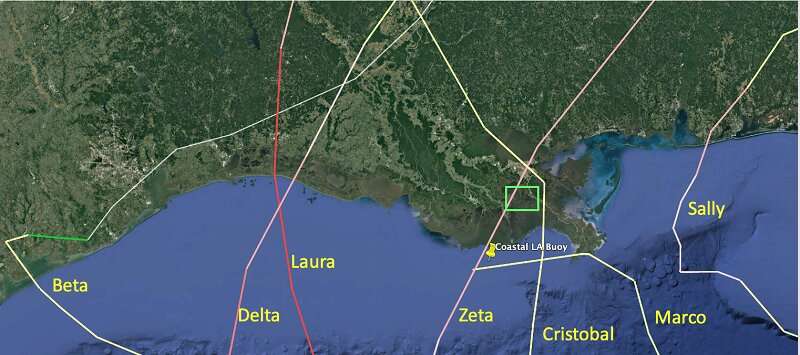After Historic 2020 Hurricane Season, LSU’s Coastal Research Highlights Post-Storm Impacts

The year 2020 now has the most named storms ever recorded in the Atlantic in a single year. In the summer and fall, the coastal bays of Louisiana have experienced impacts from a number of tropical storms and hurricanes in close procession, including Tropical Storm Marco and Hurricanes Laura, Sally, Beta, Delta and Zeta. These events have provided LSU scientists with a rare opportunity to assess how storms can exacerbate coastal erosion even when they do not directly strike vulnerable areas. This is especially concerning for Barataria Bay, Louisiana, which has one of the fastest coastal land loss rates in the nation. While studying marsh edge erosion in the bay, the scientists discovered that, even when excluding any direct strikes to the coastal basin, erosion rates were up to 60 times higher than the four-year long-term average, due to this year's storms.
The National Science Foundation has awarded a $100,937 Rapid Response Research (RAPID) grant to LSU to quantify how much carbon is being released into the atmosphere from wetlands being eroded by hurricanes and tropical storms. This project is led by John White, associate dean of research and professor in the College of the Coast & Environment, and George Xue, associate professor in the Department of Oceanography & Coastal Sciences and the Center for Computation & Technology.
What makes this project special is the fact that scientists rarely have the opportunity to assess the impact of tropical storms on erosion because they do not have detailed pre-storm measurements to compare with post-storm data; however, White and Xue had already been working on an existing NSF grant with collaborators from LSU's Department of Chemistry and University of Central Florida that included four years of extensive measurements in Barataria Bay when this year's multitude of storms struck the Louisiana coast in rapid succession. This means their team will be able to directly attribute how much erosion was caused by each of the six storms versus how much was caused by other factors.
"We happened to be in the right place at the right time for this," White said, "We have data from the same area that got hit directly and indirectly with multiple storms, and that's really unusual for that to happen and to have the measurements from before that. We're seeing how the same marsh responded to direct and indirect storm impacts where you're unlikely to have those sorts of things all happen in one location. It's like lightning striking the same place twice. It's just an unusual year."
Sampling conducted by White's Ph.D. student Yadav Sapkota shows that the long-term average erosion rate in Barataria Bay is 0.35 centimeters per day. By contrast, Tropical Storm Marco and Hurricane Laura caused a total of 22 centimeters of soil loss in just two days, despite never directly striking the bay. Hurricanes Sally and Beta caused a total of 30 centimeters of loss over the course of six total days, also without making direct landfall over the bay. Furthermore, the preliminary data reveals that in a single day Hurricane Zeta, which was a direct hit on Barataria, caused a devastating 3-meter loss to the bay, or about 10 feet in some locations.
According to White, "This is important because if you take a vertical core of soil from the bay, just a meter-and-half's worth of that soil contains 850 years' worth of carbon. Losing 850 years' worth of carbon in these storms is a dramatic loss."
The researchers are looking for not only how much erosion was caused by the rapid succession of storms but also how much carbon was released into the atmosphere as a result. Wetlands sequester carbon from the atmosphere through plant photosynthesis and by acting as sediment traps for runoff. But, when storms break off large pieces of the marsh's edge and drops them into the bay, microbes and detritivores, like crabs, treat it like a buffet, breaking down the organic matter and releasing the previously trapped carbon into the atmosphere as carbon dioxide, a greenhouse gas that contributes to climate change.
With this grant, over the next year, the research team will quantify whether accelerated erosion from the 2020 storm season will lead to a significant increase in carbon dioxide being released from the bay into the atmosphere and ocean, as well as quantifying how long the effects will persist. Xue will use the data from this research to update his existing high-resolution, three-dimensional Gulf of Mexico carbon model, which will then be used to assess the pathway of the exported carbon. In the future, other coasts around the world will experience more frequent tropical storm impacts due to the changing climate, and Xue's model will help climate modelers to generate more comprehensive projections of the increased carbon dioxide released as a result of this phenomenon.
Worldwide, wetlands make up only 5-6% of the land's surface, but they contain approximately one-third of the world's carbon captured in their soil.
"The sea level rise that is occurring in Louisiana today is what the rest of the world's going to see in 50 to 75 years. That is what everyone else is headed toward as we look at our projections," White said, "So, steps need to be taken to preserve this carbon pool that's sitting in these coastal areas because otherwise, there's so much carbon there that it will overwhelm any mitigation factors that humans put into place to try to slow increases in atmospheric CO2."
Contact Christine Wendling
LSU College of the Coast & Environment
225-578-4984
christinew@lsu.edu
OR
Alison Satake
LSU Media Relations
510-816-8161
asatake@lsu.edu
Provided by Louisiana State University